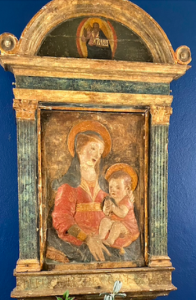
The following is a selection from Catholic University student Alessia Pecorella’s class paper on the terracotta Madonna and Child, a piece of Renaissance-era art held by Special Collections at the University. Ms. Pecorella’s piece was submitted as an assignment for Professor Tiffany Hunt’s course ART 272: The Cosmopolitan Renaissance and edited by Special Collections Archivist Shane MacDonald. The students used art from the University collections for their papers.
Before ART 272 Cosmopolitan Renaissance, I thought the Renaissance was just a definition in my high school history textbook. But throughout the semester, I have realized there is more than meets the eye during this influential period. The object I picked to study this semester was the terracotta Madonna and Child, created by Antonio Rossellino.
The terracotta Madonna and Child, according to the Catholic University Special Collections, is a plaque of the Madonna and Child in terracotta, encased in a tabernacle frame. Antonio Rossellino created the object between 1540-70. The object’s current location is in a Curley Hall Annex stairwell chapel. According to the object’s file, Frederick Jambes donated the piece, although there is correspondence with a Miss Jessie Jebiley as the potential donor. Based on the provenance history explained in the object file there is a lot of information of how the object got to campus, but not a lot of information about how the piece made its way to America in the first place.
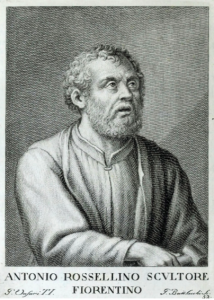
The object’s creator, Antonio Rosselino, was born in Florence, Italy and is a “notable and prolific Italian Renaissance sculptor who was the youngest brother of the architect and sculptor Bernardo Rossellino” (Encyclopædia Britannica). Rossellino’s expertise was in portraits and combining architecture and sculpting. His greatest accomplishment is the Chapel of the Cardinal of Portugal in San Miniato al Monte, located outside of Florence. The figures Rosselino formed over time are recognized for their “strong form and intense characterization” (Encyclopædia Britannica) He is known for his recurring depictions of Madonna and Child, with examples displayed in museums all around the country.
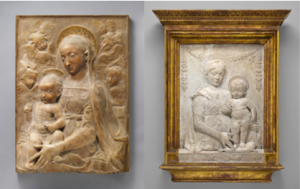
One example is his marble Madonna and Child with Angels, located in the Metropolitan Museum of Art in New York City. Another is Rossellino’s marble Madonna and Child, located in the National Art Gallery in Washington, D.C. Comparing these two works with CatholicU’s terracotta piece by the same artist is fascinating, but by looking at another artist’s Madonna and Child piece, one can see the diverse and global influences on the Renaissance. An example of this can be comparing Duccio’s Madonna and Child Enthroned with Angels to Rossellino’s terracotta Madonna and Child.
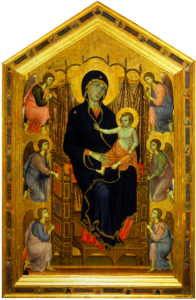
The significant difference between these two pieces is that one is a painting, and another is a sculpture, but let us compare how Mary and Jesus are depicted in these pieces. In Duccio’s piece, Mary and Jesus, he “imitated two different tiraz textiles and the drapery of the back of Mary’s throne reflect contemporary Islamic fabrics used to furnish palaces and tents” (Mack, 2002). Tiraz is a line of Arabic calligraphy on the top sleeves of a robe or a hat. Duccio’s depiction of Mary and Jesus was rare in Italian art and caught positive attention in decades to come. While in Rossellino’s piece, Mary and Jesus are sitting in a very similar position, but their clothing is different. Their clothing has no tiraz, and it utilizes three primary colors of red, blue, and gold and is more simply draped. Mary and Jesus’ facial expressions are alike in these two pieces. Both figures express a sense of peace and calmness. Even as far as the detail of Mary looking over her left shoulder down at Jesus and Jesus looking into the distance is significant – it shows the artists may have been trying to create the same perspective. These two pieces are Renaissance art with elements of humanism and Catholicism represented, but also express the diversity of cultural influences on art in this period.
To dive even further into why The terracotta Madonna and Child is defined as Renaissance art is to explain what materials make up the piece. The object’s material is terracotta. When I initially thought of Renaissance sculptures, I thought only marble was used, but that is wrong. Various materials were used throughout the period to create beautiful sculptures. Terracotta is ceramic pottery used to make pots, pipes, bricks, and sculptures created by baking clay. The word terracotta in Italian means “baked earth”. Terracotta is thousands of years old, and one of its famous examples is the Terracotta Army in China. Classical antiquity was a favored trait of the Renaissance, and terracotta was a way to represent it. Italian sculptors in this time were known for using marble and bronze, but when demand for commissions increased, artists needed to produce artwork quicker and turned to terracotta. Specifically, Florentine artists like Rosselini were fond of utilizing this material. When using it, artists shape a three-dimensional form with their hands and instruments that is made hard and brittle when cooked in a kiln. The terracotta can be modified after drying by carving or engraving. Such works can range in color from dull ochre to a bright red, and were often painted to look like marble or bronze. These techniques traveled, and people all over Europe began to utilize terracotta for works of art.
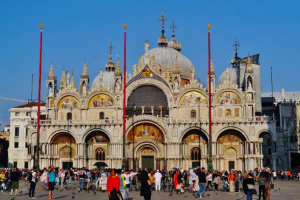
Finally, the terracotta Madonna and Child has a tabernacle frame around the sculpture. This frame’s design is one of the many details that define the terracotta Madonna and Child as a Renaissance object. A tabernacle frame is a form of an architectural picture frame that emerged in Venice and Tuscany in the fifteenth century. It was composed of a pair of pilasters that bordered the picture aperture, supported a frieze and pediment, and rested on a base. Even though tabernacle frames have similar shapes, I think the shape of the dome-like top of the tabernacle frame reminds me of the architecture of the Basilica of San Marco located in Venice. The design similarities are a connection I believe makes sense because tabernacle frames originated from Venice. In my opinion, the pillars of the frame invoke the columns of the Basilica. The tabernacle frame of the terracotta Madonna and Child is an identifiable feature of the object that connects it back to the Renaissance.
The terracotta Madonna and Child is one of the thousands of pieces of art created during the Renaissance. Through this one object, one can learn more about the Renaissance. The use of terracotta, the humanizing of Jesus and Mary, and the architecture behind the tabernacle frame all play a role in connecting this piece with the broader Renaissance. Created in sixteenth century Florence, it eventually was donated to the Catholic University in the twentieth century. And while displayed on the campus, it taught me about the Renaissance and I hope it can teach everyone else a little bit about it too.
Works Cited
“Antonio Rossellino.” Encyclopædia Britannica. Encyclopædia Britannica, inc. Accessed March 31, 2022. https://www.britannica.com/biography/Antonio-Rossellino.
Belting, Hans, and Deborah Lucas Schneider. Essay. In Florence & Baghdad: Renaissance Art and Arab Science, 41–43. Cambridge, MA: Harvard University,2011.
Farago, Claire J. “Chapter 3.” Essay. In Reframing the Renaissance: Visual Culture in Europe and Latin America, 1450-1650, 69–70. New Haven: Yale University Press, 1995.
Fliegel, Stephen N. “The Terracottas of Renaissance Florence.” La Gazzetta Italiana. Accessed April 3, 2022. https://www.lagazzettaitaliana.com/history-culture/7845-the-terracottas-of-renaissance-florence.
Mack, Rosamond. “Oriental Script in Italian Paintings.” Essay. In Bazaar to Piazza: Islamic Trade and Italian Art, 1300-1600, 56–59. Berkeley: University of California Press, 2002.
Magner, James A. Letter to Mr. Leon Medina. Washington, D.C: The Catholic University of America, January 17, 1961.
McLeod, Alice H. Letter to Mr. Leon Medina. Washington, D.C: The Catholic University of America, December 28, 1960.
Ousterhout, Robert. Journal. “Flexible Geography and Transportable Topography,” The Real and Ideal Jerusalem in Jewish, Christian and Islamic Art, 393-404. (published as Jewish Art 23-24 [1997-98])
Rosselino, Antonio. “Madonna and Child with Angels.” Metmuseum.org. Accessed April 1, 2022. https://www.metmuseum.org/art/collection/search/192716.
Rossellino, Antonio. “Madonna and Child.” Art Object Page. Accessed April 1, 2022. https://www.nga.gov/collection/art-object-page.469.html.
“Tabernacle Frame.” Oxford Reference. Accessed April 3, 2022. https://www.oxfordreference.com/view/10.1093/oi/authority.20110803101822637.
The Terracotta Madonna and Child. “ACUA Museum Collections New Museum Collection.” Washington D.C, 1960.
“What Is Terracotta?” Wonderopolis. Accessed April 2, 2022. https://www.wonderopolis.org/wonder/what-is-terracotta.
